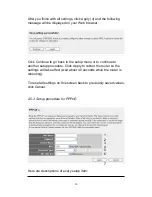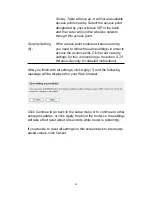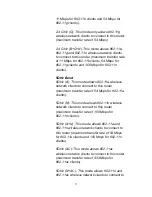
63
2-6 Wired LAN Configurations
Before all computers using wired Ethernet connections (i.e., those
computers connecting to this router’s LAN ports 1 to 4 via Ethernet
cable) can communicate with each other and access the Internet,
they must have a valid IP address.
There are two ways to assign IP addresses to computers: static IP
address (set the IP address for every computer manually), and
dynamic IP address (IP address of computers will be assigned by
the router automatically. It’s recommended for most computers to
use a dynamic IP address, as it will save a lot of time instead of
setting IP addresses for every computer, especially when there are
a lot of computers in your network; for servers and network devices
which will provide services to other computers and users that come
by way of the Internet, astatic IP address should be used so other
computers can locate the server.
If you have no idea how to define an IP address plan for your
network, here are some suggestions.
1. A valid IP address has 4 fields: a.b.c.d. For most home and
business users, it’s suggested to use 192.168.c.d, where c is
an integer from 0 to 254, and d is an integer from 1 to 254.
This router is able to work with up to 253 clients, so you can
set the “d” field of the IP address of the router as 1 or 254 (or
any number in between), and pick a number between 0 and
254 for field “c.”
2. In most cases, you should use 255.255.255.0 as a subnet
mask, which allows up to 253 clients (the router’s capability).
3. For all servers and network devices which will provide
services to other people (like Internet, print and file services),
you should use a static IP address. Assign each a unique
number from 1 to 253, and maintain a list so everyone can
locate those servers easily.
4. For computers not dedicated to provide specific service to
others, you should use dynamic IP addresses.
If you don’t fully understand the descriptions listed above, don’t
worry! Recommended setup values are presented below.
















































